Blog #3 - How to Choose the Perfect Bushcraft Knife for Your Outdoor Adventures
Author: Knife Supplies Australia Date Posted:20 April 2023
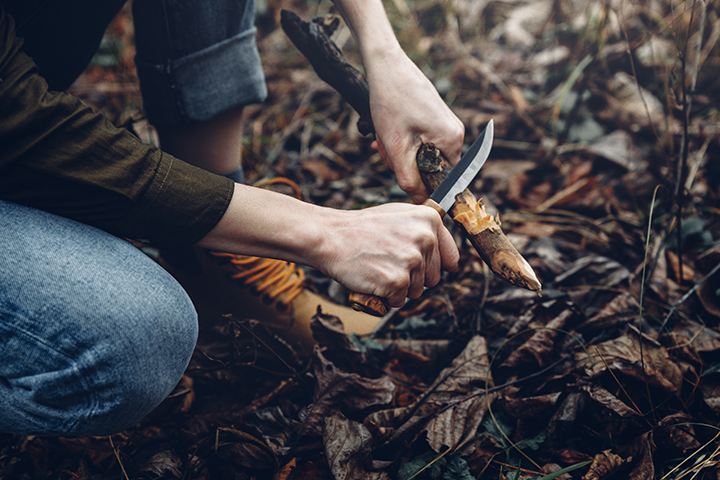
A bushcraft knife is an essential tool for any outdoor enthusiast, whether you're a seasoned bushcraft practitioner or a weekend camper looking for a versatile tool to tackle various tasks.
Unlike hunting or folding pocket knives, bushcraft knives are specifically designed for a range of bush-living and survival activities such as carving, batoning, feather stick making, and even food preparation. Choosing the perfect bushcraft knife involves considering several factors, including design, blade thickness, dimensions, specifications, blade shape, grind types, steel types, handle materials, and unique features. In this article, we will explore these factors in detail and compare various bushcraft knives to help you find the ideal tool for your outdoor adventures.
1. Understanding Bushcraft Knife Design
A well-designed bushcraft knife ensures optimal performance, durability, and comfort during use. When evaluating a knife's design, consider the following features:
- Full tang construction: This means the blade's steel extends through the entire handle, providing superior strength and durability.
- Blade length: A blade length of 3.5 to 5 inches is generally recommended for bushcraft tasks, as it offers an ideal balance between versatility and control.
- Handle ergonomics: A comfortable handle is essential for prolonged use, so look for a design that fits well in your hand and offers a secure grip.
2. Blade Thickness, Dimensions, and Specifications
Blade thickness and dimensions greatly influence a knife's performance in various bushcraft tasks. Key factors to consider include:
- Blade thickness: A thickness of 3/16 to 1/4 inch is suitable for most bushcraft tasks, as it provides a good balance between strength and cutting performance.
- Blade width: A wider blade offers increased strength for heavy-duty tasks like batoning but may compromise on slicing and carving ability.
- Blade spine: A 90-degree spine enables you to strike a fire steel or scrape wood shavings without damaging the blade's edge.
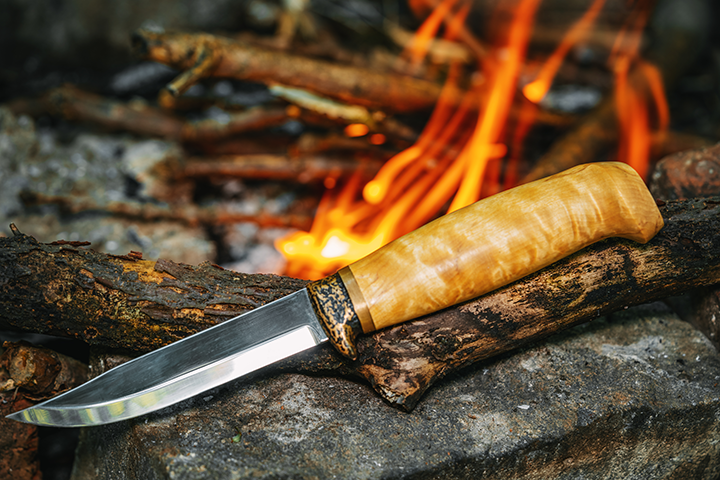
3. Blade Shape
The blade shape plays a crucial role in determining how well a knife performs specific tasks. Most commonly bushcraft knives feature a drop point blade. This versatile design features a sloping spine that meets the tip, providing a strong point and a large cutting edge ideal for various tasks. The strength of blade's tip is the reason why the drop point is the most common blade shape for bushcraft knives, as it is well suited to tasks that could snap the tip off other knife blade shapes.
4. Grind Types
The grind type refers to how the blade is sharpened and influences its cutting ability and overall performance. Common bushcraft knife grind types include:
Scandi grind:
Also known as a Scandinavian grind, is a type of knife blade grind characterized by a single, wide, flat bevel that extends from the blade's edge up to a certain point on the blade. This wide bevel creates a strong, durable edge that's ideal for woodworking tasks, such as carving, whittling, and feather sticking.
The scandi grind is known for its simplicity and ease of sharpening, as the large, flat bevel provides a consistent angle for maintaining the blade's edge. Commonly found on traditional Scandinavian knives and popular among bushcraft enthusiasts, the scandi grind offers a versatile and reliable option for a variety of outdoor tasks.
Flat grind:
A flat grind, sometimes referred to as a full flat grind, is a type of knife blade grind where the blade tapers uniformly and smoothly from the spine down to the cutting edge without any secondary bevels. This results in a blade with a thin, sharp edge and a relatively thin profile, making it a versatile choice for various cutting tasks.
Flat grinds excel at slicing, chopping, and general-purpose use, providing a balance of strength, sharpness, and ease of sharpening. Due to its sleek design and ability to tackle a wide range of tasks, the flat grind is a popular choice for many everyday carry, hunting, and bushcraft knives.
Convex grind:
A convex grind, sometimes referred to as an axe grind or Moran grind, is a type of knife blade grind where the blade tapers in a slightly rounded or outward curving manner from the spine down to the cutting edge, creating a convex shape. This results in a thick and sturdy edge that offers excellent durability and edge stability, making it ideal for heavy-duty tasks such as chopping, batoning, and splitting wood.
The convex grind is often found on axes, machetes, and some bushcraft knives due to its strength and resistance to chipping or rolling. While it may not be as sharp as some other grinds, the convex grind offers exceptional durability and is well-suited for demanding outdoor tasks that require a robust cutting edge.
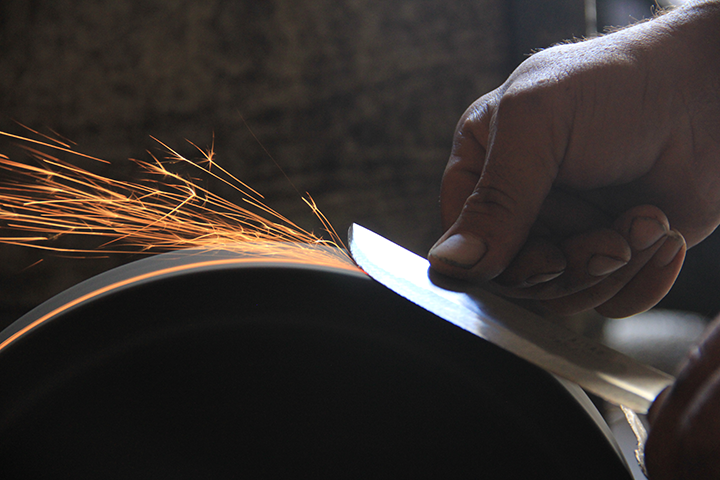
5. Steel Types
A knife's steel type determines its edge retention, corrosion resistance, and overall durability. Some popular steel types for bushcraft knives are:
- High carbon steel: This steel is known for its excellent edge retention and ease of sharpening but may be prone to rust if not maintained properly.
- Stainless steel: Providing better corrosion resistance than high carbon steel, stainless steel is ideal for humid or wet environments but may not hold an edge as well.
- Tool steel: Highly durable and wear-resistant, tool steel is well-suited for heavy-duty tasks but may require more maintenance to prevent corrosion.
Modern stainless steels are most commonly featured in bushcraft knives and include 440C, VG-10, CPM-S30V, and CPM-3V. These steel types offer a good balance of edge retention, corrosion resistance, and ease of sharpening.
440C is an affordable and widely used stainless steel that has high carbon content, making it a popular choice for budget-friendly knives.
VG-10 steel is a high-end Japanese stainless steel known for its excellent edge retention and corrosion resistance, often found in premium quality knives.
CPM-S30V, a premium American-made steel, is highly regarded for its exceptional edge retention, corrosion resistance, and durability, making it a favorite among bushcraft enthusiasts and experts alike.
CPM-3V, another premium steel from the USA, provides exceptional toughness, wear resistance, and edge retention, ideal for heavy-duty applications and demanding outdoor tasks.
Each of these steel types has unique properties that contribute to the overall performance and longevity of bushcraft knives, making them top choices for outdoor enthusiasts.
6. Handle Materials
The handle material affects the overall comfort, durability, and aesthetics of a bushcraft knife. Knife handle materials and textures play a crucial role in providing a secure and comfortable grip in various weather conditions and can be especially important to consider in wet conditions to avoid slipping. Different materials and textures have unique properties that can affect how the knife feels and performs in your hand. Some popular handle materials include:
- Wood: A classic choice, wood offers a warm, natural feel but may require additional care to prevent cracking or warping.
- Micarta: A composite material made from layers of fabric (usually linen or canvas) impregnated in resin. Micarta is durable, weather-resistant, and offers excellent grip even when wet.
- G-10: Similar to Micarta but using fiberglass rather than fabric, G-10 is a fiberglass laminate that provides a tough, lightweight, and weather-resistant handle material.
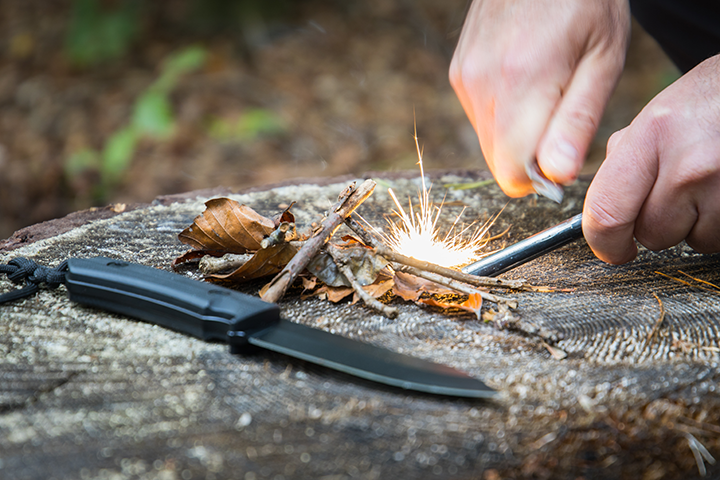
7. Unique Features
Some bushcraft knives include unique features that may enhance their functionality, such as:
- Integrated fire steel striker: This feature allows you to start a fire without carrying a separate striker, saving space in your gear.
- Lanyard hole: A hole in the handle enables you to attach a lanyard for added security during use or ease of carrying.
- Jimping: Textured notches on the blade's spine can provide additional control and grip during detailed tasks, and help to generate sparks when used to strike a fire steel.
- Survival features: Some bushcraft knives have additional survival features built in, such as the Cudeman MT-5 which features a hole in the blade where it meets the handle, in addition to the more common lanyard hole. These two holes allows the knife to be tied to a stick to create a makeshift spear.
8. Comparing Bushcraft Knives
To help you choose the perfect bushcraft knife, we will discuss the key features of five options from popular brands, including blade length, blade thickness, total length, weight, sheath information, and country of manufacture:
Beavercraft BSH1 Traditional Bushcraft Knife
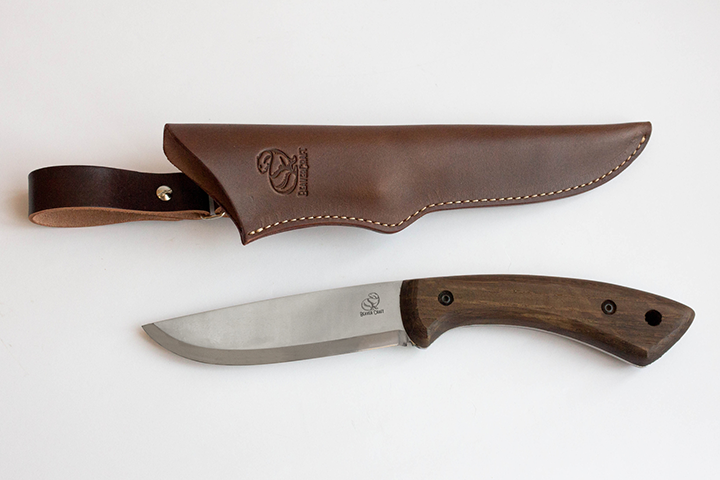
- Blade material: High carbon steel for good edge retention
- Blade length: 4.92 inches (12.5 cm)
- Blade thickness: 2.5 mm
- Total length: 10.63 inches (27 cm)
- Weight: 270 grams
- Sheath: Brown leather sheath included
- Country of manufacture: Ukraine
- Grind: Scandi grind, ideal for woodworking tasks
- Handle material: Comfortable Walnut wooden handle
- Construction: Full tang
Benchmade Sibert Bushcraft CPM-S30V
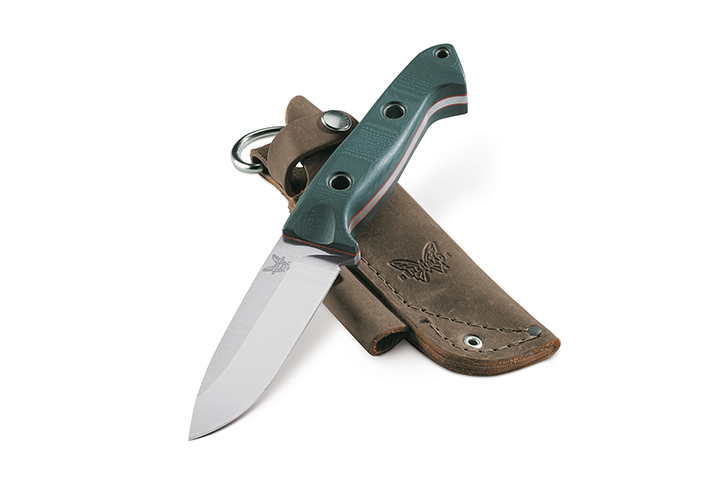
- Blade material: High-quality CPM-S30V (58-60HRC) stainless steel
- Blade length: 4.4 inches (11.18 cm)
- Blade thickness: 0.164 inches (4.17 mm)
- Total length: 9.15 inches (22.24 cm)
- Weight: 219 grams
- Sheath: Brown leather sheath included
- Sheath weight: 76.5g
- Country of manufacture: USA
- Grind: High flat grind, versatile for a variety of tasks
- Handle material: Green G-10
- Construction: Full tang
Cudeman BS9 Quercus Olive Green Canvas Vanadium Steel
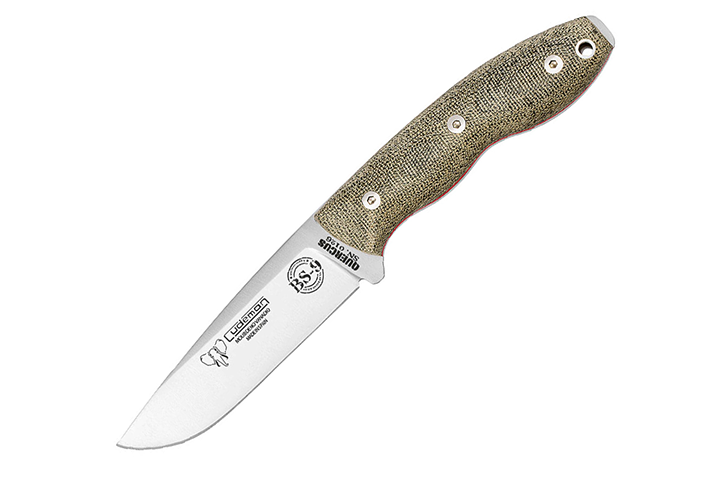
- Blade material: Molybdenum Vanadium Stainless Steel
- Blade length: 4.33 inches (11 cm)
- Blade thickness: 0.18 inches (4.5 mm)
- Total length: 9.25 inches (23.5 cm)
- Weight: 227 grams (knife only)
- Sheath: Brown leather sheath included
- Country of manufacture: Spain
- Grind: Folded flat grind
- Handle material: Green canvas Micarta with red liners
- Construction: Full tang
Cudeman MT-5 Black Micarta Bohler N-695 Steel Survival Knife
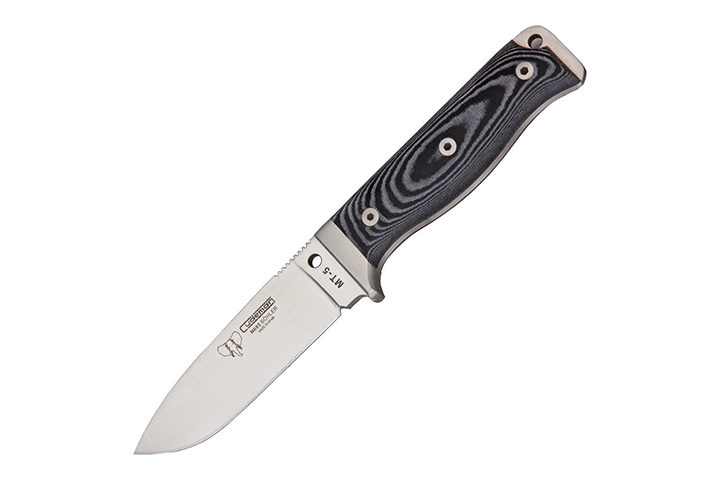
- Blade material: Austrian Bohler N-695 stainless steel
- Blade length: 4.3 inches (11 cm)
- Blade thickness: 0.2 inches (5.33 mm)
- Total length: 8.86 inches (22.5 cm)
- Weight: 247 grams (knife only)
- Sheath: Black leather sheath with red stitching included
- Country of manufacture: Spain
- Grind: High flat grind, versatile for a variety of tasks
- Handle material: Black Micarta handle
- Construction: Full tang
Mikov Patron Stonewash Bohler N690 Steel G10 Fixed Blade Knife
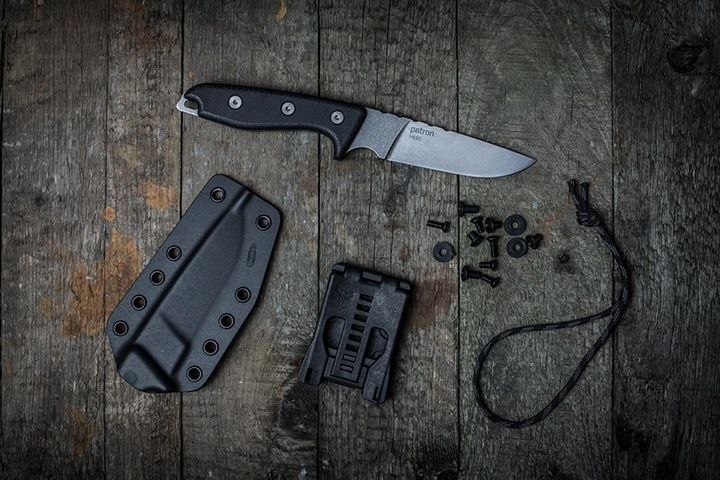
- Blade material: Austrian Bohler N690 stainless steel with stonewash finish
- Blade length: 4.37 inches (11.1 cm)
- Blade thickness: 0.18 inches (4.5 mm)
- Total length: 8.9 inches (22.6 cm)
- Total Weight: 357 grams (includes knife, sheath, belt clip, included paracord)
- Sheath: Kydex sheath included, with Tek-Lok belt clip and paracord
- Country of manufacture: Czech Republic
- Grind: Flat grind
- Handle material: Black G-10 handle
- Construction: Full tang
By examining the features of these different bushcraft knives, including blade length, blade thickness, total length, weight, sheath information, and country of manufacture, you can make an informed decision and select the ideal tool to tackle a wide range of tasks and enhance your bushcraft skills.






